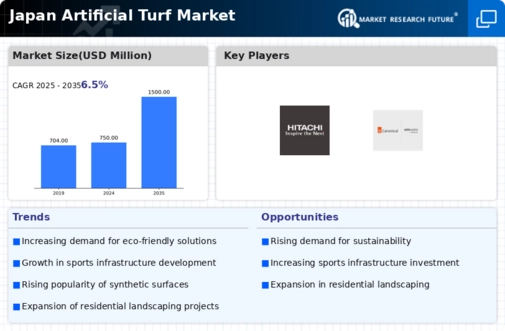Rising Demand for Sports Facilities
The increasing interest in sports and recreational activities in Japan is driving the demand for artificial turf. As more municipalities and private entities invest in sports facilities, the artificial turf market experiences growth. In 2025, the market is projected to reach approximately $300 million, reflecting a compound annual growth rate (CAGR) of around 8%. This trend is particularly evident in urban areas where space is limited, making artificial turf an attractive option for multi-use sports fields. The artificial turf market industry benefits from this rising demand as it provides durable, low-maintenance solutions that can withstand heavy usage. Furthermore, the growing popularity of sports such as soccer and rugby contributes to the expansion of artificial turf installations across schools, parks, and professional venues.
Environmental Regulations and Standards
Japan's stringent environmental regulations are influencing the artificial turf market. The government is promoting eco-friendly materials and practices, which encourages manufacturers to innovate and produce sustainable turf options. In 2025, it is estimated that around 30% of new installations will utilize environmentally friendly materials, reflecting a shift towards sustainability in the artificial turf market industry. Compliance with these regulations not only enhances the market's reputation but also attracts environmentally conscious consumers. As a result, companies that prioritize sustainable practices may gain a competitive edge, potentially increasing their market share. This regulatory landscape is likely to shape the future of the artificial turf market, pushing for advancements in material technology and installation practices.
Increased Investment in Urban Green Spaces
The Japanese government's commitment to enhancing urban green spaces is fostering growth in the artificial turf market. Initiatives aimed at creating more parks and recreational areas in urban settings are leading to a rise in artificial turf installations. By 2025, it is anticipated that urban green projects will account for approximately 25% of the total artificial turf market. This trend reflects a broader societal shift towards improving quality of life in densely populated areas. The artificial turf market industry stands to gain from these investments, as artificial turf provides a practical solution for creating green spaces that require minimal maintenance. Furthermore, these projects often emphasize sustainability, aligning with consumer preferences for eco-friendly options.
Technological Innovations in Turf Manufacturing
Technological advancements in the manufacturing of artificial turf are significantly impacting the market in Japan. Innovations such as improved fiber technology and enhanced drainage systems are making artificial turf more appealing to consumers. In 2025, it is projected that the market will see a 15% increase in demand for high-performance turf products. These innovations not only improve the aesthetic appeal of artificial turf but also enhance its durability and performance. The artificial turf market industry is likely to benefit from these advancements as they cater to a growing consumer base that seeks quality and longevity in turf products. Additionally, the integration of smart technologies, such as temperature regulation and moisture control, may further revolutionize the market.
Growing Popularity of Landscaping and Aesthetic Applications
The aesthetic appeal of artificial turf is becoming increasingly recognized in Japan, driving its adoption in landscaping applications. Homeowners and businesses are increasingly opting for artificial turf to enhance outdoor spaces, leading to a notable rise in demand. In 2025, landscaping applications are expected to represent around 20% of the artificial turf market. This trend is particularly pronounced in urban areas where traditional grass may struggle to thrive. The artificial turf market industry is likely to benefit from this growing interest, as it offers versatile solutions for creating visually appealing landscapes. Additionally, the low maintenance requirements of artificial turf make it an attractive option for property owners seeking to reduce upkeep costs while maintaining a beautiful outdoor environment.













Leave a Comment